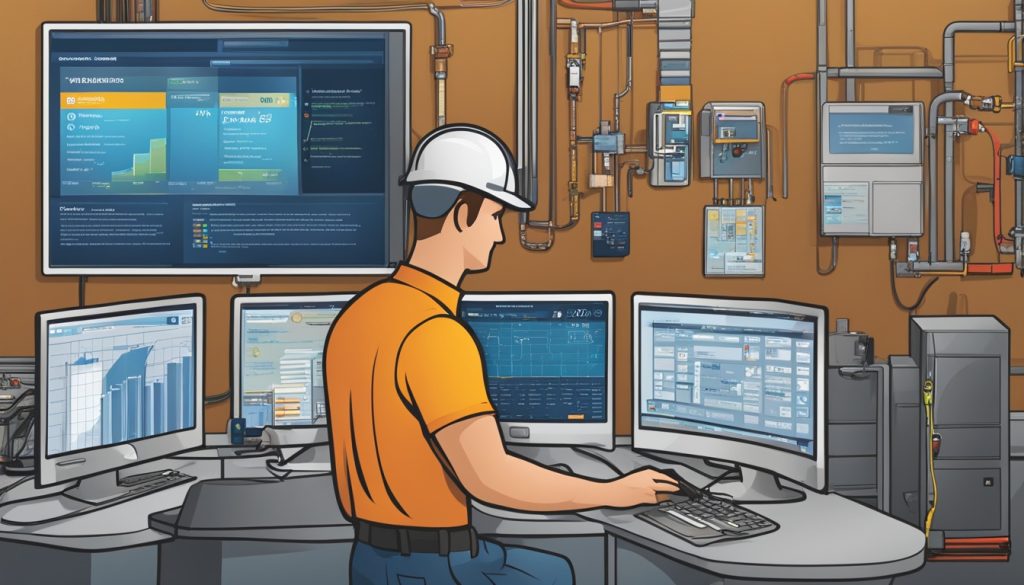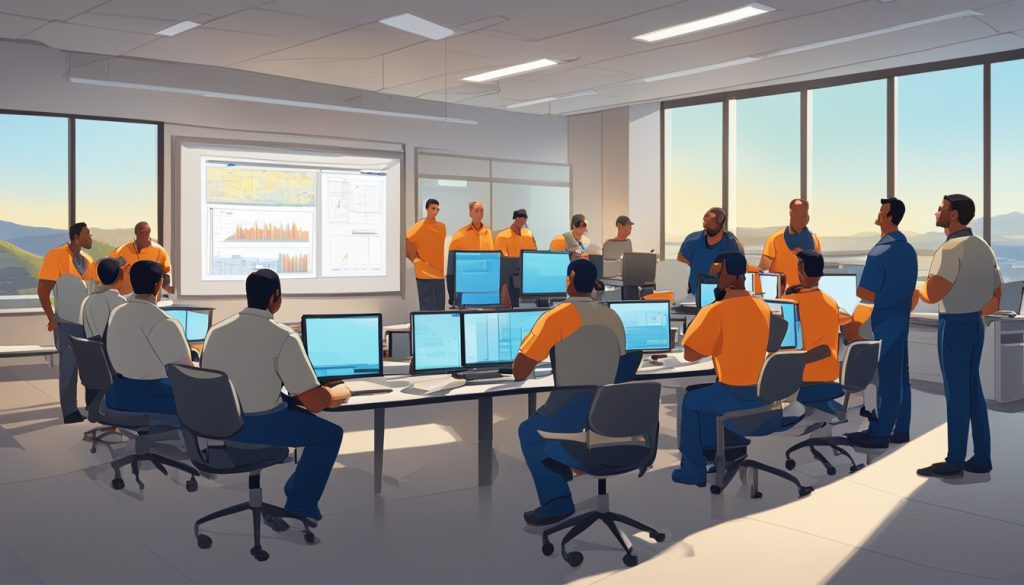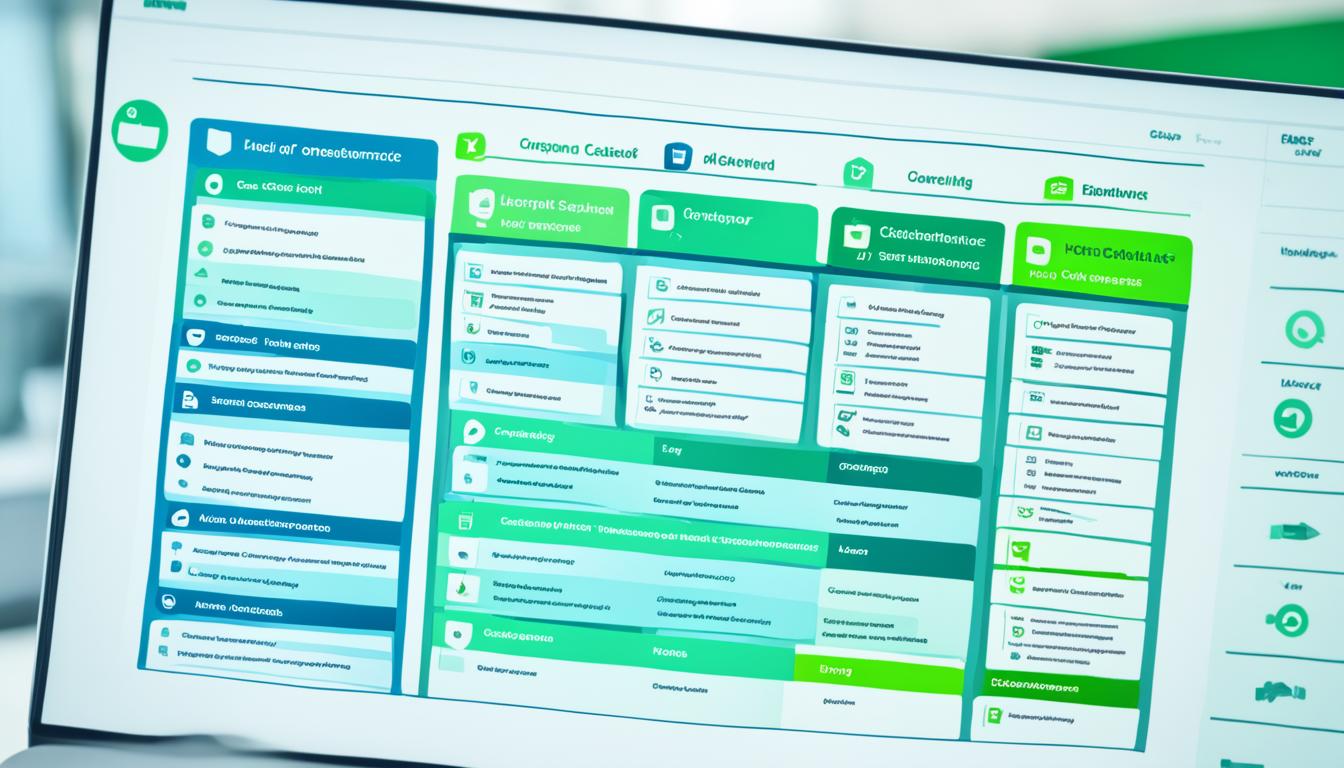Using specialized software, you can set up effective preventive maintenance for your HVAC systems. This method boosts system performance, extends equipment life, and cuts costs. With HVAC software, you manage a detailed asset list, schedule maintenance, and analyze data to reduce unexpected repairs and downtime.
Good HVAC maintenance plans mix regular checks, quick fixes, and smart decisions based on data. The right software makes these steps easier, keeping your HVAC systems running smoothly. This proactive method saves money and makes your space more comfortable and safe.
Adding HVAC software to your management plan gives you deep insights into how your systems work, how much energy they use, and maintenance patterns. This info helps you make smart choices about upgrades, where to use resources, and when to do maintenance. It leads to a more efficient and cost-saving HVAC setup.
Understanding the Importance of Preventive Maintenance for HVAC Systems
HVAC preventive maintenance is key to keeping your building’s systems running well. It helps you stay ahead, save energy, and follow the law.
Reducing Risk to People and Property
Regular checks on your HVAC system can spot issues early. This means you can avoid big problems like fires, carbon monoxide leaks, or bad air quality. It also stops expensive repairs and makes your equipment last longer.
Enhancing Energy Efficiency and System Longevity
A well-kept HVAC system uses less energy and cuts down on bills. Cleaning filters, checking refrigerant, and lubricating parts keeps it running right. This not only saves money but also makes your HVAC last longer.
Ensuring Regulatory Compliance and Operational Continuity
HVAC systems must meet many safety and environmental laws. Regular maintenance keeps you in line with these rules, avoiding fines and legal trouble. It also means less downtime, helping your business run smoothly.
Putting HVAC preventive maintenance first makes your building safer, more efficient, and legally right. It also keeps your operations running without a hitch.
Key Components of HVAC Systems and Their Maintenance Needs
Knowing the main parts of HVAC systems is key for good upkeep. Your HVAC has many important parts that work together to keep your space comfy. Let’s look at these key parts and what you need to do to keep them running right.
Heating systems are at the heart of your HVAC. Boilers and furnaces need regular checks to work well. Make sure to clean heat exchangers every year to keep them efficient and avoid problems.
Ventilation is also crucial. Air handlers and ductwork spread cooled or heated air around your building. Clean your ducts every 3-5 years to get rid of dust and dirt. Change air filters every month or every 3 months, based on how much you use them.
Air conditioning units keep your place cool when it’s hot. Central air conditioners and chillers should get checked once a year. Clean the condenser coils, check the refrigerant levels, and oil moving parts to make them last longer.
HVAC controls, like thermostats and building management systems, control your whole system. Check these devices every year to make sure they’re reading temperatures right and working efficiently.
| HVAC Component | Maintenance Task | Frequency |
|---|---|---|
| Heating Systems | Inspect and clean heat exchangers | Annually |
| Ventilation | Clean ducts | Every 3-5 years |
| Air Conditioning | Clean condenser coils | Annually |
| HVAC Controls | Calibrate thermostats | Annually |
By knowing these key parts and what they need, you can set up a good maintenance plan. This will help your HVAC system work better and last longer.
Types of Preventive Maintenance Approaches for HVAC
HVAC maintenance is key to keeping your systems efficient. Knowing the different types helps you pick the best plan for your equipment. Let’s look at three main ways to maintain HVAC systems.
Time-Based Preventive Maintenance
This method sets a schedule for HVAC checks and services. It does maintenance at regular times, not based on the system’s state. For example, you might change air filters every three months or have a full check-up every year.
Usage-Based Preventive Maintenance
This method schedules maintenance based on how much you use your HVAC. It looks at things like how long the system runs or the number of heating and cooling cycles. For example, you might get a maintenance check after every 1,000 hours of use.
Condition-Based Preventive Maintenance
This approach uses real-time monitoring of your HVAC. It looks at data from sensors to know when maintenance is needed. This way, you can fix problems early, saving time and money.
| Maintenance Type | Timing | Best For | Advantages |
|---|---|---|---|
| Time-Based | Fixed intervals | Standard equipment | Easy to schedule |
| Usage-Based | After specific runtime | Variable-use systems | Aligns with actual use |
| Condition-Based | As needed | Critical equipment | Prevents unexpected failures |
Choosing the best HVAC maintenance depends on your system’s complexity, how you use it, and its importance. The right method can improve your HVAC’s performance, make it last longer, and cut energy costs.
Selecting the Right HVAC Software for Preventive Maintenance
Choosing the right HVAC maintenance software is key for a good preventive maintenance plan. Look for features that meet your maintenance needs and help your organization’s goals.

CMMS solutions are essential for HVAC maintenance. They provide a single place for managing activities and tracking equipment. Make sure the software has strong asset management, easy maintenance scheduling, and efficient work order handling.
When picking preventive maintenance tools, focus on data analysis. These tools help you make smart choices by looking at equipment trends and maintenance history.
| Software Selection Criteria | Importance | Benefits |
|---|---|---|
| User-friendly interface | High | Increases adoption rates and productivity |
| Mobile accessibility | Medium | Enables on-site data entry and access |
| Integration capabilities | High | Streamlines workflows across systems |
| Customizable reporting | Medium | Facilitates tailored insights and analysis |
| Scalability | High | Supports business growth and expansion |
The best HVAC software should work well with your current systems and be easy for your team to use. By looking at these criteria, you’ll find a solution that boosts your preventive maintenance and improves your operations.
Implementing Preventive Maintenance with HVAC Software
HVAC software changes how we handle preventive maintenance. It makes things more efficient and keeps systems running well. Let’s see how to use HVAC software for better maintenance.
Creating a Comprehensive Asset Inventory
First, make a detailed list of your HVAC assets. Include info on each piece of equipment, where it is, and what maintenance it needs. This list helps you keep track of everything and plan maintenance well.
Setting Up Maintenance Schedules
Next, set up maintenance schedules with HVAC software. Use the maker’s advice and how often the system is used. This way, you avoid sudden problems and make your equipment last longer.
Generating and Managing Work Orders
HVAC software makes managing work orders easy. It helps create and give out maintenance tasks. This means your maintenance gets done on time and your system works better.
Tracking Maintenance History and Costs
Use the software to keep track of maintenance history. This lets you see what maintenance was done before, what problems keep happening, and how much it costs. With this info, you can make smart choices to save money and keep your maintenance program strong.
| HVAC Software Feature | Benefit |
|---|---|
| Asset Inventory Management | Improved asset tracking and maintenance planning |
| Maintenance Scheduling | Reduced system downtime and extended equipment life |
| Work Order Management | Enhanced task completion and system reliability |
| Maintenance History Tracking | Better decision-making and cost optimization |
Using these HVAC software tools, you can set up a strong preventive maintenance plan. This keeps your system running at its best and lasting longer.
Best Practices for HVAC Preventive Maintenance Scheduling
Keeping your HVAC systems running well is key. By following best practices for maintenance, you can make sure they work great and last longer. Let’s look at some important strategies for taking care of your HVAC.
Match your maintenance with the seasons. This way, you get your system ready for each season’s needs. For instance, check your cooling system in spring and your heating system in fall. Doing this helps avoid problems when you need your system the most.
Think about how important each piece of equipment is when planning maintenance. Things that affect comfort and safety should be checked more often. Make sure you find a balance so maintenance doesn’t disrupt your life but keeps your system reliable.
| Maintenance Type | Frequency | Tasks |
|---|---|---|
| Seasonal | Bi-annual | Comprehensive system checks, coil cleaning, refrigerant level inspection |
| Monthly | Every 30 days | Filter changes, basic inspections, belt tension checks |
| Quarterly | Every 3 months | Lubrication, electrical connections tightening, thermostat calibration |
Adjust your maintenance plans based on the type, age, and how much you use your equipment. New systems might need checks less often, while older ones might need more. Things that get used a lot or are older should be checked more to stop sudden failures.
Use both time-based and condition-based maintenance plans. Do regular tasks like changing filters at set times. For complex parts, check sensors or do inspections to see when maintenance is needed.
By following these maintenance tips, you’ll make your system work better, save on energy, and make it last longer. Remember, regular maintenance stops big repairs and keeps your home comfy all year.
Leveraging HVAC Software for Data Collection and Analysis
HVAC software changes how you handle your systems. It makes collecting HVAC data easier and improves maintenance analytics. With these tools, you can make better choices about your equipment’s care and performance.
Limiting Data Collection for Increased Accuracy
Focus on getting the most important info. This makes your data more accurate and easier to analyze. Collect key metrics like temperature readings, energy use, and how long the equipment runs. By not collecting too much data, you make sure what you have is useful and can be acted upon.
Utilizing Visual Documentation Features
Visual documentation is a big deal for HVAC maintenance. Use your software’s imaging features to take pictures of your equipment. These pictures help technicians spot problems fast and see how things change over time.
Analyzing Maintenance Trends and System Performance
Looking at how things perform over time is key to staying ahead. HVAC software lets you see patterns in your system’s behavior. By looking at this data, you can predict problems and plan your maintenance better.
| Data Type | Benefits | Analysis Method |
|---|---|---|
| Energy Consumption | Identify inefficiencies | Compare against benchmarks |
| Maintenance Frequency | Optimize service intervals | Track repair history |
| Temperature Fluctuations | Improve comfort levels | Monitor setpoint deviations |
Using these features turns raw data into valuable insights. This approach leads to more efficient HVAC systems and big cost savings over time.
Training Your Team to Use HVAC Maintenance Software Effectively
Starting with HVAC maintenance software is just the beginning. To get the most out of it, you must invest in thorough HVAC technician training. This training helps your team use the software’s full potential, making your systems work better and last longer.

Begin with a detailed maintenance team education plan. It should cover everything from basic to advanced software features. Make sure to focus on how to enter data correctly, as this is key for the software to work well. Add practical exercises to help your team feel confident using the system.
Continuously improving your team’s skills is important. Plan regular updates to teach them about new features and ways to maintain systems. This keeps your team up-to-date with the latest in HVAC technology and software changes.
Think about starting a mentorship program. This way, experienced technicians can help newer ones. This approach speeds up learning and encourages sharing knowledge within your team.
The success of your HVAC maintenance program depends on your team’s skill in using the software. By focusing on detailed and ongoing training, you’ll make sure your investment in HVAC software leads to better system performance, energy savings, and cost cuts.
Integrating HVAC Maintenance into Your Overall Facilities Management Strategy
Adding HVAC maintenance to your facilities plan makes your building operations more complete. It lets you use resources better and reduces downtime. This way, your HVAC system works well with other parts of the building, making it more energy-efficient and comfortable for everyone.
Using building management systems is a big part of this. These systems help you keep an eye on and control things like HVAC, lights, and security. By linking your HVAC software with these systems, you get a full view of how your building is doing.
- Coordinate HVAC maintenance with other facility tasks
- Align HVAC operations with energy efficiency goals
- Ensure HVAC maintenance supports regulatory compliance
- Use data from building management systems to inform HVAC decisions
This approach creates a strong strategy that boosts your building’s performance. It makes things run smoother and makes the place more comfortable and productive for everyone.
| Benefits of HVAC Integration | Impact on Facilities Management |
|---|---|
| Improved energy efficiency | Lower operational costs |
| Enhanced occupant comfort | Increased tenant satisfaction |
| Streamlined maintenance processes | Reduced downtime and disruptions |
| Better regulatory compliance | Minimized legal and financial risks |
For successful integration, it’s important to keep talking between your HVAC team and other staff. Regular meetings and sharing building management system access help everyone work together better. This leads to a more efficient and effective way of managing your facilities.
Measuring the Success of Your HVAC Preventive Maintenance Program
To make sure your HVAC preventive maintenance program works well, you need to check its success. This means tracking important performance indicators (KPIs), watching for energy efficiency gains, and looking at cost savings.
Selecting Appropriate Key Performance Indicators (KPIs)
Pick HVAC maintenance KPIs that match your goals. Things like equipment uptime, energy use, and maintenance costs are key to track. These metrics show how healthy your HVAC systems are and where you can get better.
Monitoring Energy Efficiency Improvements
Keep an eye on energy efficiency to see how your maintenance is doing. Look at energy use per square foot or how efficient your HVAC systems are. These figures show if your maintenance is making your systems work better and cutting energy waste.
Tracking Cost Savings and Return on Investment
Do a cost savings analysis to see what your preventive maintenance program is worth. Compare what you spend on maintenance to the savings from less reactive maintenance and longer equipment life. Figure out your ROI by looking at these costs against energy savings and avoided equipment buys. This helps prove the value of keeping up with preventive maintenance and using HVAC software.





0 Comments